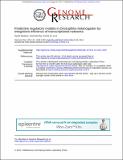Predictive Regulatory Models in of Transcriptional Networks
Author(s)
Kahveci, Tamer; Marbach, Daniel; Roy, Sushmita; Ay, Ferhat; Meyer, Patrick E.; Candeias, Rogerio; Bristow, Christopher A.; Kellis, Manolis; ... Show more Show less
DownloadKellis_Predictive regulatory.pdf (2.410Mb)
PUBLISHER_CC
Publisher with Creative Commons License
Creative Commons Attribution
Terms of use
Metadata
Show full item recordAbstract
Gaining insights on gene regulation from large-scale functional data sets is a grand challenge in systems biology. In this article, we develop and apply methods for transcriptional regulatory network inference from diverse functional genomics data sets and demonstrate their value for gene function and gene expression prediction. We formulate the network inference problem in a machine-learning framework and use both supervised and unsupervised methods to predict regulatory edges by integrating transcription factor (TF) binding, evolutionarily conserved sequence motifs, gene expression, and chromatin modification data sets as input features. Applying these methods to Drosophila melanogaster, we predict ∼300,000 regulatory edges in a network of ∼600 TFs and 12,000 target genes. We validate our predictions using known regulatory interactions, gene functional annotations, tissue-specific expression, protein–protein interactions, and three-dimensional maps of chromosome conformation. We use the inferred network to identify putative functions for hundreds of previously uncharacterized genes, including many in nervous system development, which are independently confirmed based on their tissue-specific expression patterns. Last, we use the regulatory network to predict target gene expression levels as a function of TF expression, and find significantly higher predictive power for integrative networks than for motif or ChIP-based networks. Our work reveals the complementarity between physical evidence of regulatory interactions (TF binding, motif conservation) and functional evidence (coordinated expression or chromatin patterns) and demonstrates the power of data integration for network inference and studies of gene regulation at the systems level.
Date issued
2012-03Department
Massachusetts Institute of Technology. Computer Science and Artificial Intelligence Laboratory; Massachusetts Institute of Technology. Department of Electrical Engineering and Computer ScienceJournal
Genome Research
Publisher
Cold Spring Harbor Laboratory Press
Citation
Marbach, D. et al. “Predictive Regulatory Models in Drosophila Melanogaster by Integrative Inference of Transcriptional Networks.” Genome Research 22.7 (2012): 1334–1349.
Version: Final published version
ISSN
1088-9051
1088-9051